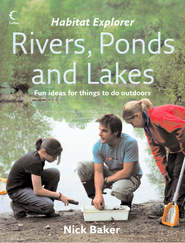По всем вопросам обращайтесь на: info@litportal.ru
(©) 2003-2024.
✖
Seashore
Автор
Год написания книги
2019
Настройки чтения
Размер шрифта
Высота строк
Поля
YOU WILL NEED
> thick, but bendable wire
> travel mirror
> gaffer tape
> scissors
1 Take 6ocm of thick but bendable wire, fold it in half and twist.
2 Bend one end at right angles and attach to a travel shaver’s mirror with reinforced gaffer tape (from a DIY shop). Make a more solid handle by binding the other end with the gaffer tape.
3 Use the mirror to shed light on those otherwise dark and sinister cracks and crevices.
4 Bend the wire into a right angle so you can look in all those rock pools. You can even get an idea of what the world is like looking up from a crab’s point of view.
The baiting game (#ulink_ce6bdd6e-8bfe-516e-8654-7659042a256e)
I remember going ‘shrimping’ as a kid, hunting for prawns for my supper. This involved tossing bait into the pools and coming back later to scoop up the unfortunate crustaceans into a net. But I found that some of the bait was seemingly being pulled by an invisible force across the bottom of the pools while other pieces exploded into hundreds of fragments, which would then be shunted around rapidly, resembling underwater fireworks. Other bits had simply disappeared! Very soon I was gazing into the pools trying to figure out who the thieves were. It was at that moment I was hooked, and so I became a rock pool investigator.
Many of the residents of rock pools are opportunists – they take whatever they can, whenever they can. They are the scavengers and the waste disposal units of the sea. By placing bait in the pools you are actually recreating something that happens all the time in nature.
When a creature dies anywhere in any ecosystem on the planet, there are a whole host of other creatures ready to return the goodness its body contains back into the living system, and rock pools are no exception. Animals die here, and our coasts are also the last resting place for many other creatures that die at sea and are washed up. Believe me, a body in a rock pool will not last long. But don’t just believe me, try it out for yourself.
Really it’s all about experimenting. Different baits may work better in different places and at different times, but the basic principle is the same. For best results, you need to spread the word to the rock pool community that bait has arrived, and you want the word to reach as many different creatures as quickly as possible.
Nick’s trick
Use the smelliest bait possible and ideally one that contains an element of ‘soup’; soft stuff that will break up into tiny particles and get wafted around in the water currents.
YOU WILL NEED
> smelly bait
> piece of string
OR
> pot of fish paste
> piece of mesh or old stocking
> elastic band
1 Bring your own bait; the smellier the better as this will waft around in the water and draw in creatures from further afield. I have used everything from scraps and trimmings that my local fishmonger has given me, like nice and smelly fish heads and tails, to bacon or ham that I have removed from my own sandwiches.
2 Attach your bait to a piece of string so you can lift the bait out of the water if a particularly greedy or boisterous crab or fish comes along. Many scavengers, such as crabs and blennies, can be very greedy and will leave the scene altogether, taking your bait with them.
3 If the idea of handling smelly dead fish bits really fills you with disgust, there is a neater little trick that also works well using a pot of fish paste. Take the lid off your pot and stir up the contents a bit. Then cover with the mesh or old stocking and secure firmly with the elastic band.
4 Pop the pot into a rock pool and that’s it! Just sit back and watch as the residents come scuttling.
Handy stuff: scavenger trap (#ulink_db5f436c-676f-56f0-a0bd-0bfd6010e280)
Around areas where there is a fishing business, you may well come across large rope and wooden structures used to catch crabs and lobsters. You can borrow this idea and make your own rock pool version.
The trap is made from a container, which lets the smell of your bait escape into the water. When the creatures come searching, they find their way in via a funnel. This then acts as a one-way valve, trapping them inside. The cheapest way to do this is with an old plastic drinks bottle.
With the aid of your scavenger trap and a field guide you will soon be able to identify many different rock pool creatures.
Nick’s trick
In an area where netted dog whelks are found, try dragging your bait around on a sandy bottom and watch what happens. These scavenging snails will follow the trail, siphons up, as they pick up the smell of the bait.
YOU WILL NEED
> old plastic drinks bottle
> scissors
> bait
> gaffer tape
> string
> plastic tank
1 Take the bottle and cut off the top about 10cm down (you might need to ask an adult to help you as this can be difficult). You will be left with a funnel and a trap box. Then make lots of small holes in the main part of the bottle.
2 Put some bait into the trap and insert the top of the bottle, neck end down. Fasten in place with strips of gaffer tape.
3 Search out some large, flat stones and attach them to the bottle using string. They look like little packages and will weight down your trap, which is important as a drifting trap spells death for all those caught inside. Plastic bottles are also one of the worst kinds of litter.
4 Position the trap in a rock pool and then leave for a few hours.
5 You will want to take a closer look at what you’ve caught, so carefully place your captives in an observation tank to study them.
Marvellous molluscs (#ulink_cb9b6488-fda0-5473-87d4-507715a04b70)
These simple little cone-shaped shells are a familiar sight on a wave-beaten rocky shore. Their shell design and body shape are perfect for resisting the constant battering of the ocean. These molluscs have a large circular foot, which allows them to clamp tight to the rocks on which they live, making them very hard to prise off the rocks without doing any damage.
A combination of their habitual behaviour and the abrasive action of their shells on the rock means that they will often wear away the rock’s surface, leaving small circular pits as evidence of their home base. You can also sometimes see grazing trails similar to those left by their land-based relatives, the garden snails.
You might think that watching limpets is about as much fun as watching your parents tan! But you can turn even the dullest beach into a study zone. What do you know about these little molluscs? Not a lot, OK. So follow the steps opposite and you will learn a little bit more. This technique is used by biologists to study the movement of all kinds of animals.
Nick’s tricks








